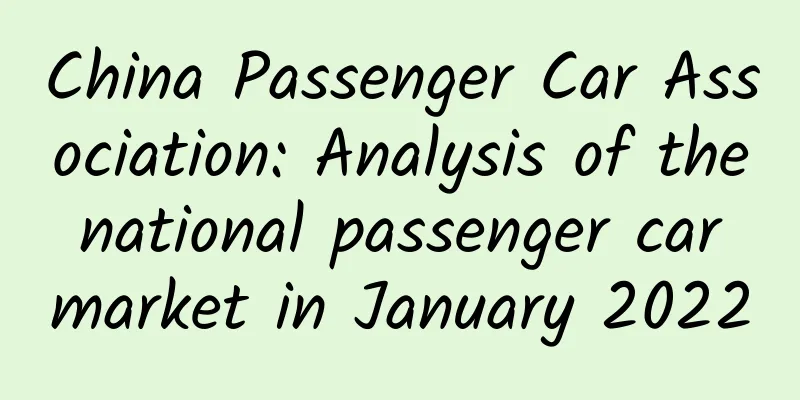China Passenger Car Association: Analysis of the national passenger car market in January 2022

|
1. Review of the national passenger car market in January Retail: In January 2022 , the passenger car market retail sales reached 2.092 million units, a year -on-year decrease of 4.4% and a decrease of 0.6% compared with December 2021. The overall retail trend in January was good. Since the Spring Festival holiday started on January 31 , but production lines stopped before the holiday and consumers bought cars a few days earlier, 3-5 days were lost in January due to the Spring Festival , which is estimated to have caused a production and sales loss of about 15% . Therefore, the retail sales in January showed good growth both month-on-month and year-on-year. Since the autumn and winter, the epidemic prevention and control has been repeated, but this year's Spring Festival " staying in place for the Spring Festival " and other epidemic prevention calls have been relaxed compared with the same period last year, and the scale of residents returning home has increased significantly, with the national passenger volume increasing by more than 40% year-on-year. The large-scale return of residents has provided some support for car purchases in some central and western provinces, counties, towns and cities, and the increased promotion efforts before the festival have also boosted the wave of car purchases in the hometowns. With the gradual strengthening of production and wholesale sales in the past few months, the overall market supply has shown a warming trend, and manufacturers are actively welcoming a " good start " in the new year . In particular, terminal promotions continued to shrink significantly after July 2021 until November . Since December , promotions have increased slightly, bringing continued strength in retail. As the inventory level of models on sale at the dealer level improved and the structure continued to be optimized, the pace of manufacturers' supply gradually met expectations. With the arrival of the pre-holiday sales peak season, dealers significantly increased terminal discounts in January , sales enthusiasm increased rapidly, and terminal retail sales strengthened. In January , luxury car sales reached 290,000 units, down 5% year-on-year and up 18% month-on-month . Luxury car sales at the beginning of the year were significantly stronger month-on-month, indicating a strong growth trend for traditional luxury cars in the new year. In January , domestic brands sold 940,000 vehicles, up 11% year-on-year and 1% month-on-month . In January , the domestic retail share of domestic brands was 45.5% , up 6.4 percentage points year-on-year; compared with the annual share of 41% in 2021 , it increased by 4.5 percentage points. In January , the wholesale market share of domestic brands was 46.4% , up 4.3 percentage points from the same period; compared with the annual share of 44% in 2021 , it increased by 2.4 percentage points. The leading domestic brands performed very well and gained significant growth in the new energy market. Therefore, traditional car brands such as BYD and Chery all showed high year-on-year growth. In January , mainstream joint venture brands sold 860,000 vehicles, down 17% year-on-year and 7% month-on-month . Localized outbreaks have affected the production rhythm in megacities such as Tianjin, suppressing the increase in production and sales. In January , the retail share of Japanese brands was 19.2% , down 2.2 percentage points year-on-year. The share of German brands was 23.5% , down 2.3 percentage points year-on-year. The retail share of American brands reached 8.2% , down 1.2 percentage points year-on-year. The share of French brands increased by 0.1 percentage points.
Exports: According to the statistics of the China Passenger Car Association, passenger car exports (including complete vehicles and CKD ) in January reached 169,000 units, a year-on-year increase of 91% , and new energy vehicles accounted for 30% of the total exports . In January , the export of independent brands reached 107,000 units, a year-on-year increase of 56% , and the export of joint ventures and luxury brands reached 61,000 units, with outstanding year-on-year growth. Production: In January , passenger car production was 2.059 million units, up 10.4% year-on-year and down 16.5% month-on-month , showing a slightly weaker performance. Among them, luxury brand production increased by 16% year -on-year and decreased by 12 % month-on-month ; joint venture brand production increased by 2% year -on-year and decreased by 20% month-on-month ; independent brand production increased by 17% year-on-year and decreased by 14% month-on-month . In January , the production and sales growth in the auto market was relatively good. Although there were slight production losses in some regions, the chip supply continued to improve, which promoted the increase in production and sales in January . Wholesale: In January , manufacturers' wholesale sales volume was 2.172 million vehicles, a year-on-year increase of 6.8% and a month-on-month decrease of 8.2% . The performance of some automakers due to production constraints was differentiated. Inventory: The first three quarters of 2021 experienced a special cycle from destocking to approaching safe inventory. In the fourth quarter, manufacturers' inventories were quickly replenished, laying the foundation for the strong performance of retail and exports in January . In January , manufacturers' inventories fell by 110,000 vehicles, and channel inventories fell by 90,000 vehicles month-on-month. January of each year is an important node for destocking. This January , the inventory was removed well, laying the foundation for a good start in the new year. New energy: In January , the wholesale sales of new energy passenger vehicles reached 412,000 units, a year-on-year increase of 141.4% and a month-on-month decrease of 18.5 %, which is consistent with the characteristics of January 2021. In January , the retail sales of new energy passenger vehicles reached 347,000 units, a year-on-year increase of 132.0% and a month -on-month decrease of 27.0% , which is basically consistent with the 25% characteristics in January 2021 . Before the Spring Festival, new energy vehicles and traditional fuel vehicles showed a synchronized strengthening trend. There was strong demand for first-time entry-level consumption and traditional car replacement before the Spring Festival. In addition, the strong growth of new energy vehicles promoted the overall growth of passenger car market retail. In the new energy market, sales were weak in early January due to the concentrated delivery of vehicles at the end of last year, but rebounded significantly in the second and third weeks. Overall, although there are still sporadic local cases of the epidemic in China, especially in megacities such as Beijing, Tianjin, Hangzhou and Shenzhen where new energy vehicles are mainly sold, relatively mild epidemic prevention measures have no significant impact on residents' travel and car purchases. 1) Wholesale: In January , the wholesale penetration rate of new energy vehicle manufacturers was 19.0% , an increase of more than 10 percentage points from the penetration rate of 8.4% in January 2021. In January , the penetration rate of new energy vehicles of independent brands was 32.0% ; the penetration rate of new energy vehicles in luxury cars was 22.9% ; and the penetration rate of new energy vehicles of mainstream joint venture brands was only 2.7% . In January , the wholesale sales of pure electric vehicles were 333,000 units, a year-on-year increase of 130.4% ; the sales of plug-in hybrid vehicles were 79,000 units, a year-on-year increase of 202.1% . In January , the sales of high-end electric vehicles grew strongly, and the trend of mid- and low-end models was also strong. The dumbbell-shaped structure of the pure electric market has improved. Among them, the wholesale sales of A00- level vehicles were 105,000 units, accounting for 32% of the pure electric market ; the wholesale sales of A0- level vehicles were 51,000 , accounting for 15% of the pure electric market ; the A - level electric vehicles accounted for 22% of the pure electric market ; the B- level electric vehicles reached 101,000 units, a month-on-month decrease of 14% , accounting for 30% of the pure electric market . 2) Retail: In January , the domestic retail penetration rate of new energy vehicles was 16.6% , an increase of 10 percentage points from the penetration rate of 6.8 % in January 2021. In January , the penetration rate of new energy vehicles among independent brands was 31.4% ; the penetration rate of new energy vehicles among luxury cars was 10.2% ; and the penetration rate of new energy vehicles among mainstream joint venture brands was only 2.5% . 3) Export: In January , 52,000 new energy vehicles were exported , maintaining strong growth. Tesla China exported 40,499 vehicles, SAIC Passenger Vehicle exported 4,814 new energy vehicles , Dongfeng EasyGo exported 4,267 vehicles, Geely Auto exported 444 vehicles, Great Wall Motor exported 408 vehicles, SAIC Maxus exported 406 vehicles, and BYD exported 313 vehicles. The new energy vehicles of other automakers were mainly sold in the domestic market. 4) Automakers: In January , the new energy passenger car market was diversified. BYD's pure electric and plug-in hybrid dual-drives consolidated the leading position of its own brand in new energy; traditional automakers represented by SAIC Group and GAC Group performed relatively well in the new energy sector. There were 11 companies whose wholesale sales exceeded 10,000 vehicles , a significant increase of 6 over the same period , including: BYD 93,101 vehicles, Tesla China 59,845 vehicles, SAIC-GM-Wuling 40,007 vehicles, Chery Automobile 21,179 vehicles, Geely Automobile 17,036 vehicles, GAC Aion 16,031 vehicles, SAIC Passenger Cars 14,414 vehicles, Great Wall Motors 13,781 vehicles , Xiaopeng Motors 12,922 vehicles, Ideal Auto 12,268 vehicles, and Nezha Auto 11,009 vehicles. 5) New forces: In January , the sales of new forces such as Xpeng, Ideal, Weilai, Nezha, Leapmotor, and WM Motor performed well year-on-year and month-on-month, especially Xpeng, Ideal, and Nezha, which exceeded 10,000 units. Second-tier companies such as Leapmotor also quickly increased their sales to more than 5,000 units per month. Among the mainstream joint venture brands , Volkswagen and Volkswagen sold 13,661 new energy vehicles wholesale , accounting for 59% of the mainstream joint venture market share. Volkswagen's firm electrification transformation strategy has begun to bear fruit. SAIC-GM's new energy sales of 4,249 units are also excellent, and other joint ventures and luxury brands still need to make efforts. 6) Hybrid: In January , the wholesale volume of hybrid passenger cars was 67,000 , up 58% year-on-year and down 20% month-on-month . Among them, Toyota sold 38,741 units, Honda sold 18,516 units, Dongfeng Nissan sold 5,424 units, and Great Wall Motor sold 1,890 units. Hybrid has gradually become a new hot spot. 2. Outlook for the national passenger car market in February 2022 Due to the early Spring Festival this year, the auto market entered the Spring Festival dormant period in the last week of January. Compared with February 2021, there were 11 fewer days of pre-holiday hot selling period, but the early dormant period a few days before the Spring Festival was also reduced. Therefore, there is not much pressure on the auto market to grow year-on-year. Due to the early suspension of production before the January holiday, channel inventory was still at a low level after the strong auto sales in January . As automakers quickly resumed normal production and sales after the holiday, dealers still had a good demand for replenishing inventory in February . The economic situation in 2022 is becoming increasingly complex and severe, and the real estate market has peaked and is showing a clear downward trend. In the short term, the regulation of the real estate industry will be in a trend of tight balance, and some related industries will face greater growth pressure and weak market expectations. Due to the impact of the epidemic, the recovery of production and life after the holiday and the service industry was cautious, and the prevention and control efforts of major events such as the Winter Olympics were strengthened. The auto market recovered slowly in February . However, with the return of middle-aged migrant workers, the structural recovery of the auto market faces good opportunities. Some traditional automakers have lowered their expectations for 2021 due to the impact of chips , and the undelivered order resources have been transferred to the first quarter of the 2022 auto market, so efforts to ensure a good start and guaranteed delivery will be implemented and effective in the first quarter. With the decline in new energy subsidies and rising raw material prices, the price adjustments of some models in the early stage led to a brief slump in orders. After the Spring Festival, the price acceptance of new energy vehicles recovered. In addition, many new energy vehicles still have a backlog of undelivered orders in the early stage. Therefore, the sales of new energy vehicles in February will not be significantly affected by the decline. There has been a certain wave of car purchases before the start of school after the Spring Festival in previous years. Traffic congestion in large cities is basically divided by the start and end of school. As the risk of the spread of the epidemic still exists, it is expected that the car purchases before the start of school this year should still be very good. Therefore, the growth rate of wholesale and retail sales in February should be worth looking forward to . 3. A slight price increase for new energy vehicles will not affect sales growth
With the recent decline in subsidies for new energy vehicles and the sharp rise in the prices of basic resources such as lithium ore, new energy vehicle companies are facing certain cost pressures. However, the market price of new energy vehicles is not expected to rise significantly, and car companies should be able to resolve the pressure and continue to maintain the rapid growth of new energy vehicles in 2022. From market feedback, users also have a certain degree of consensus and expectations on the price changes after the decline of new energy vehicles. The national new energy vehicle market is booming in 2021. According to the data from the China Passenger Car Association, domestic new energy vehicle retail sales reached 2.99 million units, a year-on-year increase of 170% . Due to the strong demand for terminal new energy, insufficient production capacity, and abundant undelivered orders (including large fixed prices to pass on costs to automakers), a slight price increase will not seriously affect the overall market demand. In 2022 , many automakers have set ambitious production and sales targets, so we are confident that the sales of new energy passenger vehicles will reach about 5.5 million units in 2022 , continuing to achieve a high growth of about 70% . National policies provide huge support for new energy vehicles. As the subsidy technical indicators remain unchanged in 2022 and the battery and vehicle integration technology is improving, new energy vehicle products are expected to receive better subsidy support by improving battery energy density, reducing power consumption per 100 kilometers and other technical indicators. The stability of subsidy technical indicators is also conducive to the continuous improvement of the industry's average technical level and alleviates the investment pressure of some companies under the policy-following strategy. The scale effect of new energy vehicles is obvious, and the scale of each vehicle of leading enterprises continues to increase and the cost decreases. With the substantial growth of the industry scale, the costs of fixed asset depreciation of new energy vehicles can be better shared, and the manufacturing cost of each vehicle is more likely to play the scale advantage in the exponential growth stage. According to the financial reports released by Tesla and other companies, the gross profit of each vehicle is at a high level of 30% , reflecting a strong ability to resist cost risks, which also injects new vitality into intelligent manufacturing and technological innovation in the manufacturing industry. The cost pressure of batteries can be resolved in many ways. Car companies may improve cost pressure and communication efficiency by improving battery performance, diversifying supplier selection, and incorporating supplier development into internal corporate transactions. The 4680 battery, which is currently developing beyond expectations, has a lot of room for cost reduction. The global investment in the battery industry is unprecedented, and short-term profits are far less important than the stable supply of car companies. The pricing system of traditional fuel vehicles is affected by high taxes on consumer goods. New energy vehicles do not have tax pressures such as consumption taxes, but instead have more new energy credits, so high-end new energy vehicles have huge potential profits. The battery capacity of BYD, GAC Aion and other models is not much different from that of high-end vehicles, but the price difference is large, reflecting the high cost performance of A- class vehicles. However, due to differences in consumer demand, high-end vehicles are extremely popular relative to A- class domestic models, so there is not much price pressure on high-end vehicles. The competition in the mainstream A0- class electric vehicles is fierce, and the cost pressure is huge, but the price remains stable, which also provides a good foundation for the higher growth of new energy vehicles. 4. Women's car use has become a strong driving force for the growth of the auto market According to statistics from the Ministry of Public Security, as of 2021 , the number of motor vehicles in China reached 395 million, including 302 million cars; the number of motor vehicle drivers reached 481 million, including 444 million car drivers . In 2021 , 36.74 million new motor vehicles were registered nationwide , and 27.5 million new drivers were licensed . In 2021 , the number of motor vehicle drivers reached 480 million, an increase of 25.5 million, which is relatively strong. Judging from the data of previous years, the growth in 2021 is relatively high, but considering that the growth in 2020 was 20.5 million, the two together should be said to be an average of 23 million per year, which is still at a relatively low level in history. Therefore, the contribution of the increase in the number of drivers to the increase in the auto market is generally not large, which is not conducive to the growth of entry-level passenger car consumption. New energy users are getting younger, and the demand for automobiles by those born after 1990 is different from the overall demand, such as the increase in demand for intelligent networking and the high requirements for automobile technology, which drives the growth of high-end electric vehicles, so the new forces are very strong. In terms of the gender of drivers, there are 319 million male drivers , accounting for 66.32% ; there are 162 million female drivers, accounting for 33.68% . At present, the growth rate of female drivers is relatively fast, especially in the past two years, reaching 160 million now, from 70 million in 2014 to 160 million in 2021 , with a rapid growth of about 13 million every year , indicating that overall, the proportion of households with multiple vehicles is constantly increasing, and there is a large room for growth in the second car of the family. In terms of driver age, by the end of 2021 , there will be 69.66 million drivers aged 51 to 60 , accounting for 14.48% , an increase of 23.03 million from 46.63 million in 2018 , a cumulative increase of 50% . The average age of German car buyers is 52 years old. In the future, the increase in car purchases by middle-aged and elderly people in China will become a force that cannot be ignored in the auto market. New energy vehicles performed very well in 2021. Due to the impact of the epidemic, the motorcycle market grew strongly and personalized travel grew rapidly. Although the number of drivers did not grow fast, the number of female drivers and middle-aged and elderly drivers grew rapidly, which is the growth point of the auto market. However, the lack of young people has brought concerns to the long-term development of the auto market. Therefore, the growth of the auto market mainly depends on consumption upgrading, and the popularization of private car consumption has encountered bottlenecks. In the face of the growing trend of aging and female users, relying on the rapid development of new energy vehicles, promoting the implementation of the C5 driver's license for micro electric vehicles, expanding the number of micro electric vehicle drivers, and allowing micro electric vehicles to continue to transform towards compliance as soon as possible, so that the auto market has greater population support is an urgent task. 5. Promoting consumption of traditional fuel vehicles in 2022 is also important Under the influence of the global COVID-19 pandemic in the past two years, the biggest highlight of China's economy has been the high growth of foreign trade. In 2021 , China's annual import and export scale reached a new level, breaking the 6 trillion US dollar mark for the first time, and the national import and export trade increased by 30% compared with 2020. In 2021 , in US dollars, China's foreign trade volume increased by 1.4 trillion US dollars, and the trade surplus reached a new high of 676.5 billion US dollars. In this case, based on the analysis of the import and export structure and the international trade balance, we need to increase domestic consumption growth and at the same time target consumption growth in the imported car market to achieve a better balance in trade among major trading countries. According to the data from the China Passenger Car Association, the traditional fuel vehicle market for passenger cars continued to decline, with a decline of 8% in 2019 , a year-on-year decline of 8% in 2020 , and a year -on-year decline of 6% in 2021 , including a year-on-year decline of 22% in December 2021. It can be seen that the traditional fuel vehicle market has been declining rapidly for several consecutive years, and traditional fuel vehicles of independent brands are also under pressure of continued decline. Under the current tax system, the production and use of fuel vehicles bring huge tax contributions. In 2021 , the national tax revenue was 172,731 billion yuan, an increase of 11.9% year-on-year ; of which domestic consumption tax was 13,881 billion yuan, an increase of 15.4% year-on-year . Vehicle purchase tax was 352 billion yuan, a year-on-year decrease of 0.3% . The current vehicle purchase tax is mainly contributed by traditional fuel vehicles. As the market size of traditional fuel vehicles decreases, the tax on fuel vehicles is also decreasing. Consumers buy electric cars mainly because of the tax benefits, including exemption from vehicle purchase tax and consumption tax, and exemption from gasoline consumption tax during the use stage. Therefore, the low-cost advantage of electric cars is largely due to the tax exemption advantage of tax policies. In the short term, fuel prices remain at a relatively high level, and the feature of half a liter of tax for one liter of oil is very obvious. If the gasoline price is below 3 yuan, the cost advantage of electric cars will be greatly reduced. At present, some consumers still buy fuel vehicles for the low cost. Many traditional fuel vehicles of domestic brands are priced below 80,000 yuan , which is also a great price advantage. However, with the increase in the cost of use, many entry-level consumers cannot afford fuel vehicles, and the price of mainstream electric vehicles is even more expensive, so car purchases are suppressed. Encouraging family fuel vehicle consumption still has positive significance at this stage. 6. Marriage should be encouraged in the face of the world’s declining birthrate – car purchase tax is waived when married The Opinions of the CPC Central Committee and the State Council on Strengthening Work on Aging in the New Era pointed out that it is necessary to study and formulate supporting policies such as housing, improve the tiered electricity, water and gas price policies, and encourage adult children to live nearby or together with their elderly parents, fulfill their maintenance obligations and take on care responsibilities. This is a good way to deal with aging. The declining birthrate is a derivative result of social progress, increasing life pressure and social development. China is facing severe characteristics of declining birthrate, which is a common characteristic problem in East Asia. China has entered a situation similar to that of Japan, South Korea, Singapore and other countries. At present, improving the population structure mainly involves increasing the number of births, which naturally means encouraging marriage. As society continues to mature, the phenomenon of not getting married is increasing, especially among young people in big cities, who have more freedom not to get married. Therefore, there is a difference between social needs and personal choices. It is necessary to encourage marriage, increase social stability, and bring more opportunities for social development. At present, our marriage problem is more serious than the fertility problem. Many high-end groups have a relatively negative attitude towards marriage and lack confidence, which needs to be guided. We must accelerate the change of young people's views on marriage and fertility and encourage marriage. Getting married and having children is necessary for the reproduction of our society and is also the responsibility of many citizens. We should carry forward traditional concepts and cultivate stronger concepts of marriage and childbearing. We not only have to face the aging population, but also the world's trend of declining birthrates. We need to cultivate young people's ideas about marriage and childbearing, so that more young people dare to get married and are willing to have children, and promote the structural enhancement of our young groups. Therefore, we should encourage marriage and support the purchase of cars by first-time married people. my country's current policy of encouraging marriage and childbirth also needs to be gradually established, especially local governments should take measures to support marriage through tax-free car purchases, etc. It is recommended that when the civil affairs department issues a certificate, certain car purchase coupons and tax-free quotas should be given to first-time marriages, and the cost should be borne by the central and local governments, so as to achieve the effect of guiding society to encourage consumption. |
<<: Core Consulting: Light Commercial Vehicle Market Forecast Research Report in January 2022
>>: Domestic TV series become popular IPs and lead the fan economy
Recommend
Product and operation analysis of the popular social product SOUL!
Everyone says that 2018 is a cold winter for the ...
Contraceptive pills in urban sewage could cause freshwater ecosystem collapse
Ingredients from oral contraceptives in sewage tr...
20,000 words of pure dry goods丨The inner strength of community operation
This sentence is a line from the movie "The ...
Pinduoduo’s fission marketing skills!
Pinduoduo has always been a classic example of fi...
To do Zhihu traffic promotion, you must master the skills!
There is no project that cannot be handled by tra...
The Shenzhou 13 manned spacecraft is about to return home. What are the steps for astronauts to get home?
According to the China Manned Space Engineering O...
Why is it that dumplings are an indispensable part of every northern Chinese New Year meal?
Audit expert: Wang Guoyi Postdoctoral fellow in N...
Himalaya FM product analysis!
Pan-entertainment has always been in the limeligh...
Bidding promotion: How to control ocpc?
We know that currently there are two types of bid...
The "black box" that is often sought in air crashes turns out not to be black!
The "black box" that is often sought in...
Miaopu Personal Information: Is SEO keyword optimization ineffective? Details cannot be ignored
Now when we are doing SEO optimization, many webs...
We are all familiar with hello world, but you don’t know its great history
[[154357]] This is the most famous program. For e...
One billion snow crabs mysteriously disappeared, and not being able to eat crab legs is just a trivial first step
Red snow crab legs as long as your arm are the cr...
LeEco Super 4 Max65 first review: Home theater is the ultimate goal of living room entertainment
Undoubtedly, the greatest contribution of the bir...
What kind of smartphone do we need in 2015?
January 29 (Reporter Zhang Zhichang) At the fourt...









